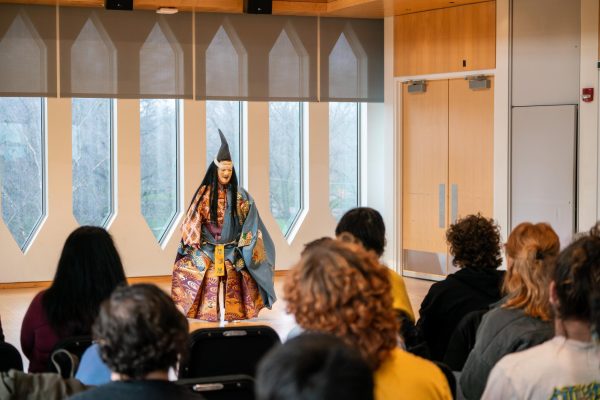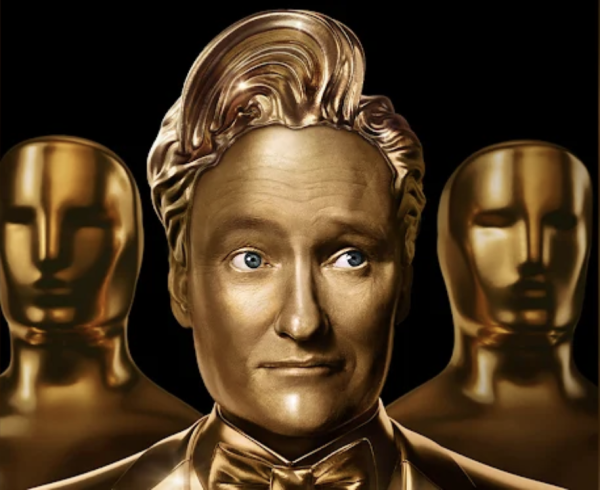“Expanded Cinema” Film Screening Challenges Students to Think Beyond Two — Or Perhaps Three — Dimensions
The 3D movie fad has declined in the past few years, but it wasn’t long ago that Hollywood studios were aggressively marketing their summer blockbusters in three dimensions. Multiplexes gleefully cashed in on audiences willing to fork over nearly $20 for the sensory spectacles.
The cynical commercialism of, say, a Transformers film has since blemished 3D film technology. Now, if I’m putting on a pair of novelty glasses in a darkened theater, at best, I’ve wasted money on an overblown, in-your-face version of a decent movie. Right?
Wrong. Take two films shown Monday night in the Clarence Ward Art Building, in the second installment of the Cinema Artists’ Cinema 16mm film series. This week’s event, “Expanded Cinema,” hosted by Visiting Assistant Professor of Modern and Contemporary Art History James Hansen, featured four short experimental films. Three of these required two simultaneous projectors for their 3D effects.
Jodie Mack’s 2013 work Let Your Light Shine kicked the evening off, for which Dr. Hansen handed out pairs of “prismatic glasses” to audience members. They produced a similarly immersive, disorienting, and psychedelic effect to 3D glasses .
“[It was] like going to a movie with two kaleidoscopes in your eyes,” said College sophomore Nathan Taubkin.
In an email to the Review, Dr. Hansen wrote, “the way [Mack] uses 3D both ‘expands’ our understanding of vision and makes it extraordinarily physical and tactile.”
Mack uses refraction to explode two-dimensional black-and-white images into shimmering rainbow-striped halos at a midpoint between the screen and the viewer’s eyes. The film is a three-minute, rapid-fire, white-on-black collage of dancing dots, lines, polygons, and familiar decorative patterns paired with a synchronized soundtrack of squeaks and blips. With the glasses on, those white-on-black dancing abstractions become rave-like iridescent dancing abstractions. Like Mack’s other work, Let Your Light Shine is playful and aggressively overstimulating. As the event opener, it achieved Dr. Hansen’s desired effect: to “kind of blow everyone’s eyes out of whack.”
The program’s closing film, Paul Sharits’ Shutter Interface, predates Mack’s film by 38 years, yet it engages similarly with 3D to create an abstract, quasi-hallucinatory experience. This 25-minute film required two projectors to run separate reels of flashing and shuttering color sequences, composed mainly of red, cyan, and magenta, all creating a strobe-like effect.
The two projections overlapped in the middle to produce three distinct fields of color side-by-side. In contrast to Let Your Light Shine — which cycles rapidly through an arsenal of visuals — precious few changes occur throughout Shutter Interface, allowing the viewer to enter something like a trance.
“The strobing was so intense, you just kind of melted into it … it was very immersive,” College first-year Leah George said. In this state, it doesn’t take long to begin seeing the three-color fields as two perspectives converging on one, creating a spontaneous, ephemeral popping effect.
Although Dr. Hansen mainly situated Shutter Interface in the context of “color field” painters like Ellsworth Kelly and Barnett Newman — slightly older contemporaries of Sharits’ — the film was also in conversation with anaglyph 3D, the “old-fashioned” mode of 3D that uses two color-tinted projections and lenses with corresponding colors. Anaglyph technology has existed in some form since as early as the 1850s, and Hollywood began producing dozens of 3D movies each year in the 1950s using this tech.
What made Let Your Light Shine and Shutter Interface exemplary was the way they don’t use 3D, distinguishing themselves from movies like Transformers. Both Mack and Sharits create 3D-like experiences, although a better word might be “hypervisual.” Neither film focuses on the pop-up book effect we jaded moviegoers know well by now. Instead, they construct unique, ingenious, and thrilling experiences which transcend their 2D format and enter into other dimensions — perfect for a series based around the intricacies of cinema as an art form.









